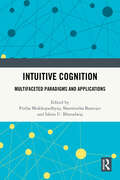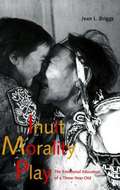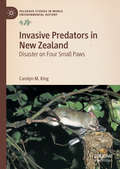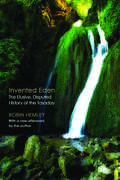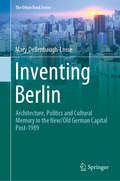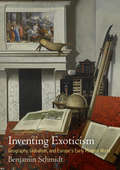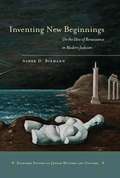- Table View
- List View
Intuitive Cognition: Multifaceted Paradigms and Applications
by Ishita U. Bharadwaj Pritha Mukhopadhyay Sharmistha BanerjeeThis book is an exhaustive and evidence-based introduction to the concepts of intuitive cognition. It focuses on the foundations of intuitive and other forms of cognition, how it allows the integration of new information with existing knowledge along with their applications in diverse fields like business, teaching, marketing and education. The book examines the co-existence of intuition with deliberate information processing and defines the applicability of intuitive cognition from a multidisciplinary approach. What role does intuition play in driving effort, sensory experience, choices or in taking risks? And how can a greater understanding of intuitive cognition help with decision-making, understanding customers or patients and understanding student needs? It explores the efficacy of the unconscious and other forms of cognition, across multiple domains, such as creative art, education, organization, business and finance, neuro-marketing, artificial intelligence and spirituality.This volume will be useful for scholars and researchers of psychology, neuroscience, cognitive psychology, cognitive sciences, education, organizational behaviour, management studies, philosophy, and literature.
Inuit Morality Play: The Emotional Education of a Three-Year-Old
by Jean L. Briggs"Is your mother good?" "Are you good?" "Do you want to come live with me?" Inuit adults often playfully present small children with difficult, even dangerous, choices and then dramatize the consequences of the child's answers. They are enacting in larger-than-life form the plots that drive Inuit social life--testing, acting out problems, entertaining themselves, and, most of all, bringing up their children. In a riveting narrative, psychological anthropologist Jean L. Briggs takes us through six months of dramatic interactions in the life of Chubby Maata, a three-year-old girl growing up in a Baffin Island hunting camp. The book examines the issues that engaged the child--belonging, possession, love--and shows the process of her growing. Briggs questions the nature of "sharedness" in culture and assumptions about how culture is transmitted. She suggests that both cultural meanings and strong personal commitment to one's world can be (and perhaps must be) acquired not by straightforwardly learning attitudes, rules, and habits in a dependent mode but by experiencing oneself as an agent engaged in productive conflict in emotionally problematic situations. Briggs finds that dramatic play is an essential force in Inuit social life. It creates and supports values; engenders and manages attachments and conflicts; and teaches and maintains an alert, experimental, constantly testing approach to social relationships.
Inuit Stories of Being and Rebirth: Gender, Shamanism, and the Third Sex (Contemporary Studies on the North #6)
by Claude Lévi-Strauss Bernard Saladin D'AnglureUjarak, Iqallijuq, and Kupaaq were elders from the Inuit community on Igloolik Island in Nunavut. The three elders, among others, shared with Bernard Saladin d’Anglure the narratives which make up the heart of Inuit Stories of Being and Rebirth. Through their words, and historical sources recorded by Franz Boas and Knud Rasmussen, Saladin d’Anglure examines the Inuit notion of personhood and its relationship to cosmology and mythology. Central to these stories are womb memories, narratives of birth and reincarnation, and the concept of the third sex—an intermediate identity between male and female. As explained through first-person accounts and traditional legends, myths, and folk tales, the presence of transgender individuals informs Inuit relationships to one another and to the world at large, transcending the dualities of male and female, human and animal, human and spirit. This new English edition includes the 2006 preface by Claude Lévi-Strauss and an afterword by Bernard Saladin d’Anglure.
Inuit, Oblate Missionaries, and Grey Nuns in the Keewatin, 1865-1965
by Jarich G. Oosten Frédéric B. LaugrandOver the century between the first Oblate mission to the Canadian central Arctic in 1867 and the radical shifts brought about by Vatican II, the region was the site of complex interactions between Inuit, Oblate missionaries, and Grey Nuns – interactions that have not yet received the attention they deserve. Enriching archival sources with oral testimony, Frédéric Laugrand and Jarich Oosten provide an in-depth analysis of conversion, medical care, education, and vocation in the Keewatin region of the Northwest Territories. They show that while Christianity was adopted by the Inuit and major transformations occurred, the Oblates and the Grey Nuns did not eradicate the old traditions or assimilate the Inuit, who were caught up in a process they could not yet fully understand. The study begins with the first contact Inuit had with Christianity in the Keewatin region and ends in the mid-1960s, when an Inuk woman joined the Grey Nuns and two Inuit brothers became Oblate missionaries. Bringing together many different voices, perspectives, and experiences, and emphasizing the value of multivocality in understanding this complex period of Inuit history, Inuit, Oblate Missionaries, and Grey Nuns in the Keewatin, 1865–1965 highlights the subtle nuances of a long and complex interaction, showing how salvation and suffering were intertwined.
Invaders as Ancestors
by Peter GoseSince pre-Incan times, native Andean people had worshipped their ancestors, and the custom continued even after the arrival of the Spaniards in the sixteenth century. Ancestor-worship however, did not exclude members of other cultures: in fact, the Andeans welcomed outsiders as ancestors. Invaders as Ancestors examines how this unique cultural practice first facilitated Spanish colonization and eventually undid the colonial project when the Spanish attacked ancestor worship as idolatry and Andeans adopted Spanish political and religious forms to challenge indigenous rulers. In this work, Peter Gose demonstrates the ways in which Andeans converted conquest confrontations into relations of kinship and obligation and then worshipped Christianized and racially "white" spirits after the Spaniards invaded, though the conquering Spaniards prevented actual kinship bonds with the Andeans by adhering to strict rules of racial separation. Invaders as Ancestors explores an alternative response to colonization beyond the predictable resistance narrative, presenting instead a creative form of transculturation under the agency of the Andeans. Invaders as Ancestors is a fascinating account of one of the most unusual transcultural encounters in the history of colonialism.
Invasive Predators in New Zealand: Disaster on Four Small Paws (Palgrave Studies in World Environmental History)
by Carolyn M. KingThe story of invasive species in New Zealand is unlike any other in the world. By the mid-thirteenth century, the main islands of the country were the last large landmasses on Earth to remain uninhabited by humans, or any other land mammals. New Zealand’s endemic fauna evolved in isolation until first Polynesians, and then Europeans, arrived with a host of companion animals such as rats and cats in tow. Well-equipped with teeth and claws, these small furry mammals, along with the later arrival of stoats and ferrets, have devastated the fragile populations of unique birds, lizards and insects. Carolyn M. King brings together the necessary historical analysis and recent ecological research to understand this long, slow tragedy. As a comprehensive historical perspective on the fate of an iconic endemic fauna, this book offers much-needed insight into one of New Zealand’s longest-running national crises.
Invented Eden: The Elusive, Disputed History of the Tasaday
by Robin HemleyIn 1971 Manual Elizalde, a Philippine government minister with a dubious background, discovered a band of twenty-six “Stone Age” rain-forest dwellers living in total isolation. The tribe was soon featured in American newscasts and graced the cover of National Geographic. But after a series of aborted anthropological ventures, the Tasaday Reserve established by Ferdinand Marcos was closed to visitors, and the tribe vanished from public view. Twelve years later, a Swiss reporter hiked into the area and discovered that the Tasaday were actually farmers whom Elizalde had coerced into dressing in leaves and posing with stone tools. The “anthropological find of the century” had become the “ethnographic hoax of the century.” Or maybe not. Robin Hemley tells a story that is more complex than either the hoax proponents or the authenticity advocates might care to admit. It is a gripping and ultimately tragic tale of innocence found, lost, and found again. The author provides an afterword for this Bison Books edition.
Inventing 'Easter Island'
by Beverley HaunEaster Island, or Rapa Nui as it is known to its inhabitants, is located in the Pacific Ocean, 3600 kilometres west of South America. Annexed by Chile in 1888, the island has been a source of fascination for the world beyond the island since the first visit by Europeans in 1722 due to its intriguing statues and complex history. Inventing 'Easter Island' examines narrative strategies and visual conventions in the discursive construction of 'Easter Island' as distinct from the native conception of 'Rapa Nui.' It looks at the geographic imaginary that pervaded the eighteenth century, a period of overwhelming imperial expansion. Beverley Haun begins with a discussion of forces that shaped the European version of island culture and goes on to consider the representation of that culture in the form of explorer texts and illustrations, as well as more recent texts and images in comic books and kitsch from off the island. Throughout, 'Easter Island' is used as a case study of the impact of imperialism on the view of a culture from outside. The study hinges on three key points - an inquiry into the formation of 'Easter Island' as a subject; an examination of how the constructed space and culture have been shaped, reshaped, and represented in discursive spaces; and a discussion of cultural memory and how the constraints of foreign texts and images have shaped thought and action about 'Easter Island.'Richly illustrated and unique in its findings, Inventing 'Easter Island' will appeal to cultural theorists, anthropologists, educators, and anyone interested in the history of the South Pacific.
Inventing America's First Immigration Crisis: Political Nativism in the Antebellum West (Catholic Practice in North America)
by Luke RitterWhy have Americans expressed concern about immigration at some times but not at others? In pursuit of an answer, this book examines America’s first nativist movement, which responded to the rapid influx of 4.2 million immigrants between 1840 and 1860 and culminated in the dramatic rise of the National American Party. As previous studies have focused on the coasts, historians have not yet completely explained why westerners joined the ranks of the National American, or “Know Nothing,” Party or why the nation’s bloodiest anti-immigrant riots erupted in western cities—namely Chicago, Cincinnati, Louisville, and St. Louis. In focusing on the antebellum West, Inventing America’s First Immigration Crisis illuminates the cultural, economic, and political issues that originally motivated American nativism and explains how it ultimately shaped the political relationship between church and state.In six detailed chapters, Ritter explains how unprecedented immigration from Europe and rapid westward expansion reignited fears of Catholicism as a corrosive force. He presents new research on the inner sanctums of the secretive Order of Know-Nothings and provides original data on immigration, crime, and poverty in the urban West. Ritter argues that the country’s first bout of political nativism actually renewed Americans’ commitment to church-state separation. Native-born Americans compelled Catholics and immigrants, who might have otherwise shared an affinity for monarchism, to accept American-style democracy. Catholics and immigrants forced Americans to adopt a more inclusive definition of religious freedom. This study offers valuable insight into the history of nativism in U.S. politics and sheds light on present-day concerns about immigration, particularly the role of anti-Islamic appeals in recent elections.
Inventing America: A History of the United States
by Pauline Maier Merritt Roe Smith Alexander Keyssar Daniel J. KevlesW. W. Norton presents Inventing America, a balanced new survey of American history by four outstanding historians. The text uses the theme of innovation—the impulse in American history to "make it new"—to integrate the political, economic, social, and cultural dimensions of the American story. From the creation of a new nation and the invention of the corporation in the eighteenth century, through the vast changes wrought by early industry and the rise of cities in the nineteenth century, to the culture of jazz and the new nation-state of the twentieth century, the text draws together the many ways in which innovation—and its limits—have marked American history.
Inventing Australia: Images And Identity, 1688-1980 (Australian Experience Ser. #No. 3)
by Richard White'White sets himself a most ambitious task, and he goes remarkably far to achieving his goals. Very few books tell so much about Australia, with elegance and concision, as does his' - Professor Michael Roe'Stimulating and informative. an antidote to the cultural cringe' - Canberra Times'To be Australian': what can that mean? Inventing Australia sets out to find the answers by tracing the images we have used to describe our land and our people - the convict hell, the workingman's paradise, the Bush legend, the 'typical' Australian from the shearer to the Bondi lifesaver, the land of opportunity, the small rich industrial country, the multicultural society.The book argues that these images, rather than describing an especially Australian reality, grow out of assumptions about nature, race, class, democracy, sex and empire, and are 'invented' to serve the interests of particular groups.There have been many books about Australia's national identity; this is the first to place the discussion within an historical context to explain how Australians' views of themselves change and why these views change in the way they do.
Inventing Baby Food
by Amy BentleyFood consumption is a significant and complex social activity--and what a society chooses to feed its children reveals much about its tastes and ideas regarding health. In this groundbreaking historical work, Amy Bentley explores how the invention of commercial baby food shaped American notions of infancy and influenced the evolution of parental and pediatric care. Until the late nineteenth century, infants were almost exclusively fed breast milk. But over the course of a few short decades, Americans began feeding their babies formula and solid foods, frequently as early as a few weeks after birth. By the 1950s, commercial baby food had become emblematic of all things modern in postwar America. Little jars of baby food were thought to resolve a multitude of problems in the domestic sphere: they reduced parental anxieties about nutrition and health; they made caretakers feel empowered; and they offered women entering the workforce an irresistible convenience. But these baby food products laden with sugar, salt, and starch also became a gateway to the industrialized diet that blossomed during this period. Today, baby food continues to be shaped by medical, commercial, and parenting trends. Baby food producers now contend with health and nutrition problems as well as the rise of alternative food movements. All of this matters because, as the author suggests, it's during infancy that American palates become acclimated to tastes and textures, including those of highly processed, minimally nutritious, and calorie-dense industrial food products.
Inventing Benjy: William Faulkner’s Most Splendid Creative Leap
by Frédérique SpillInventing Benjy: William Faulkner’s Most Splendid Creative Leap is a groundbreaking work at the intersection of Faulkner studies and disability studies. Originally published in 2009 by Presses de la Sorbonne Nouvelle as L’Idiotie dans l’œuvre de Faulkner, this translation brings the book to English-language readers for the first time. Author Frédérique Spill begins with a sustained look at the monologue of Benjy Compson, the initial first-person narrator in Faulkner’s The Sound and the Fury. Spill questions the reasons for this narrative choice, bringing readers to consider Benjy’s monologue, which is told by a narrator who is deaf and cognitively disabled, as an impossible discourse. This paradoxical discourse, which relies mostly on senses and sensory perception, sets the foundation of a sophisticated poetics of idiocy. Using this form of writing, Faulkner shaped perspective from a disabled character, revealing a certain depth to characters that were previously only portrayed on a shallow level. This style encompasses some of the most striking forms and figures of his leap into modern(ist) writing. In that respect, Inventing Benjy thoroughly examines Benjy’s discourse as an experimental workshop in which objects and words are exclusively modelled by the senses. This study regards Faulkner’s decision to place a disabled character at the center of perception as the inaugural and emblematic gesture of his writing. Closely examining excerpts from Faulkner’s novels and a few short stories, Spill emphasizes how the corporal, temporal, sensorial, and narrative figures of "idiocy" are reflected throughout Faulkner’s work. These writing choices underlie some of his most compelling inventions and certainly contribute to his unmistakable writing style. In the process, Faulkner’s writing takes on a phenomenological dimension, simultaneously dismantling and reinventing the intertwined dynamics of perception and language.
Inventing Berlin: Architecture, Politics and Cultural Memory in the New/Old German Capital Post-1989 (The Urban Book Series)
by Mary Dellenbaugh-LosseThis book comprehensively examines post-1989 changes to the symbolic landscape of Berlin – specifically, street names, architecture, urban planning and monuments – and links these changes to concepts of contested cultural memory and national identity in Berlin and Germany in the post-Wall period. The core of the book is made up of an analysis of built space changes in the eastern half of the city before and after the Berlin Wall, flanked by an introduction to the theoretical underpinnings of the topic and a wider interpretation of the events in Berlin in relation to other geographic and historical contexts. It furthermore offers an explanatory model for the phenomenon of the "symbolic foreigner" whereby former citizens of the GDR feel disenfranchised and excluded from today's German society. This book is a valuable resource for researchers, students, and also appeals to a wider, non-academic audience with an interest in both cultural memory and Berlin.
Inventing Disaster: The Culture Of Calamity From The Jamestown Colony To The Johnstown Flood
by Cynthia A. KiernerWhen hurricanes, earthquakes, wildfires, and other disasters strike, we count our losses, search for causes, commiserate with victims, and initiate relief efforts. Amply illustrated and expansively researched, Inventing Disaster explains the origins and development of this predictable, even ritualized, culture of calamity over three centuries, exploring its roots in the revolutions in science, information, and emotion that were part of the Age of Enlightenment in Europe and America. Beginning with the collapse of the early seventeenth-century Jamestown colony, ending with the deadly Johnstown flood of 1889, and highlighting fires, epidemics, earthquakes, and exploding steamboats along the way, Cynthia A. Kierner tells horrific stories of culturally significant calamities and their victims and charts efforts to explain, prevent, and relieve disaster-related losses. Although how we interpret and respond to disasters has changed in some ways since the nineteenth century, Kierner demonstrates that, for better or worse, the intellectual, economic, and political environments of earlier eras forged our own twenty-first-century approach to disaster, shaping the stories we tell, the precautions we ponder, and the remedies we prescribe for disaster-ravaged communities.
Inventing Disease and Pushing Pills: Pharmaceutical Companies and the Medicalisation of Normal Life
by Jörg BlechThis is a highly accessible and reassuring account of how the pharmaceutical industry is redefining health, making it a state that is almost impossible to achieve. Many normal life processes – states as natural as birth, ageing, sexuality, unhappiness and death – are systematically being reinterpreted as pathological so creating new markets for their treatments. In this enlightening book, Jörg Blech reveals:how the invention of diseases by pharmaceutical companies is turning us all into patients, and how we can protect ourselves against this how the medical profession has been bullied and co-opted into endorsing profitable cures for people who aren't illfears about how pharmaceutical companies create markets by playing on the general public's concern with their health.A self-help book in the truest sense, Inventing Disease and Pushing Pills reassures us about our own health. It is essential reading for doctors, nurses and patients alike.
Inventing Equal Opportunity
by Frank DobbinEqual opportunity in the workplace is thought to be the direct legacy of the civil rights and feminist movements and the landmark Civil Rights Act of 1964. Yet, as Frank Dobbin demonstrates, corporate personnel experts--not Congress or the courts--were the ones who determined what equal opportunity meant in practice, designing changes in how employers hire, promote, and fire workers, and ultimately defining what discrimination is, and is not, in the American imagination. Dobbin shows how Congress and the courts merely endorsed programs devised by corporate personnel. He traces how the first measures were adopted by military contractors worried that the Kennedy administration would cancel their contracts if they didn't take "affirmative action" to end discrimination. These measures built on existing personnel programs, many designed to prevent bias against unionists. Dobbin follows the changes in the law as personnel experts invented one wave after another of equal opportunity programs. He examines how corporate personnel formalized hiring and promotion practices in the 1970s to eradicate bias by managers; how in the 1980s they answered Ronald Reagan's threat to end affirmative action by recasting their efforts as diversity-management programs; and how the growing presence of women in the newly named human resources profession has contributed to a focus on sexual harassment and work/life issues. Inventing Equal Opportunity reveals how the personnel profession devised--and ultimately transformed--our understanding of discrimination.
Inventing Equality: Reconstructing the Constitution in the Aftermath of the Civil War
by Michael BellesilesThe evolution of the battle for true equality in America seen through the men, ideas, and politics behind the 13th, 14th, and 15th Amendments passed at the end of the Civil War. On July 4, 1852, Frederick Douglass stood in front of a crowd in Rochester, New York, and asked, “What to the slave is the Fourth of July?” The audience had invited him to speak on the day celebrating freedom, and had expected him to offer a hopeful message about America; instead, he’d offered back to them their own hypocrisy. How could the Constitution defend both freedom and slavery? How could it celebrate liberty with one hand while withdrawing it with another? Theirs was a country which promoted and even celebrated inequality. From the very beginning, American history can be seen as a battle to reconcile the large gap between America’s stated ideals and the reality of its republic. Its struggle is not one of steady progress toward greater freedom and equality, but rather for every step forward there is a step taken in a different direction. In Inventing Equality, Michael Bellesiles traces the evolution of the battle for true equality—the stories of those fighting forward, to expand the working definition of what it means to be an American citizen—from the Revolution through the late nineteenth century. He identifies the systemic flaws in the Constitution, and explores through the role of the Supreme Court and three Constitutional amendments—the 13th, 14th, and 15th—the ways in which equality and inequality waxed and waned over the decades.
Inventing Exoticism: Geography, Globalism, and Europe's Early Modern World (Material Texts)
by Benjamin SchmidtAs early modern Europe launched its multiple projects of global empire, it simultaneously embarked on an ambitious program of describing and picturing the world. The shapes and meanings of the extraordinary global images that emerged from this process form the subject of this highly original and richly textured study of cultural geography. Inventing Exoticism draws on a vast range of sources from history, literature, science, and art to describe the energetic and sustained international engagements that gave birth to our modern conceptions of exoticism and globalism.Illustrated with more than two hundred images of engravings, paintings, ceramics, and more, Inventing Exoticism shows, in vivid example and persuasive detail, how Europeans came to see and understand the world at an especially critical juncture of imperial imagination. At the turn to the eighteenth century, European markets were flooded by books and artifacts that described or otherwise evoked non-European realms: histories and ethnographies of overseas kingdoms, travel narratives and decorative maps, lavishly produced tomes illustrating foreign flora and fauna, and numerous decorative objects in the styles of distant cultures. Inventing Exoticism meticulously analyzes these, while further identifying the particular role of the Dutch—"Carryers of the World," as Defoe famously called them—in the business of exotica. The form of early modern exoticism that sold so well, as this book shows, originated not with expansion-minded imperialists of London and Paris, but in the canny ateliers of Holland. By scrutinizing these materials from the perspectives of both producers and consumers—and paying close attention to processes of cultural mediation—Inventing Exoticism interrogates traditional postcolonial theories of knowledge and power. It proposes a wholly revisionist understanding of geography in a pivotal age of expansion and offers a crucial historical perspective on our own global culture as it engages in a media-saturated world.
Inventing Fear of Crime
by Murray LeeOver the past four decades the fear of crime has become an increasingly significant concern for criminologists, victimologists, policy makers, politicians, police, the media and the general public. For many practitioners reducing fear of crime has become almost as important an issue as reducing crime itself. The identification of fear of crime as a serious policy problem has given rise to a massive amount of research activity, political discussion and intellectual debate. Despite this activity, actually reducing levels of fear of crime has proved difficult. Even in recent years when many western nations have experienced reductions in the levels of reported crime, fear of crime has often proven intractable. The result has been the development of what amounts to a fear of crime industry. Previous studies have identified conceptual challenges, theoretical cul-de-sacs and methodological problems with the use of the concept fear of crime. Yet it has endured as both an organizing principal for a body of research and a term to describe a social malady. This provocative, wide ranging book asks how and why fear of crime retains this cultural, political and social scientific currency despite concerted criticism of its utility? It subjects the concept to rigorous critical scrutiny taking examples from the UK, North America and Australia. Part One of Inventing Fear of Crime traces the historical emergence of the fear of crime concept, while Part Two addresses the issue of fear of crime and political rationality, and analyses fear of crime as a tactic or technique of government. This book will be essential reading on one of the key issues in government and politics in contemporary society.
Inventing George Whitefield: Race, Revivalism, and the Making of a Religious Icon
by Jessica M. ParrEvangelicals and scholars of religious history have long recognized George Whitefield (1714-1770) as a founding father of American evangelicalism. But Jessica M. Parr argues he was much more than that. He was an enormously influential figure in Anglo-American religious culture, and his expansive missionary career can be understood in multiple ways. Whitefield began as an Anglican clergyman. Many in the Church of England perceived him as a radical. In the American South, Whitefield struggled to reconcile his disdain for the planter class with his belief that slavery was an economic necessity. Whitefield was drawn to an idealized Puritan past that was all but gone by the time of his first visit to New England in 1740.Parr draws from Whitefield's writing and sermons and from newspapers, pamphlets, and other sources to understand Whitefield's career and times. She offers new insights into revivalism, print culture, transatlantic cultural influences, and the relationship between religious thought and slavery. Whitefield became a religious icon shaped in the complexities of revivalism, the contest over religious toleration, and the conflicting role of Christianity for enslaved people. Proslavery Christians used Christianity as a form of social control for slaves, whereas evangelical Christianity's emphasis on "freedom in the eyes of God" suggested a path to political freedom. Parr reveals how Whitefield's death marked the start of a complex legacy that in many ways rendered him more powerful and influential after his death than during his long career.
Inventing Herself: Claiming a Feminist Intellectual Heritage
by Elaine ShowalterSure to take its place alongside the literary landmarks of modern feminism, Elaine Showalter's brilliant, provocative work chronicles the roles of feminist intellectuals from the eighteenth century to the present. With sources as diverse as A Vindication of the Rights of Woman and Scream 2, Inventing Herself is an expansive and timely exploration of women who possess a boundless determination to alter the world by boldly experiencing love, achievement, and fame on a grand scale. These women tried to work, travel, think, love, and even die in ways that were ahead of their time. In doing so, they forged an epic history that each generation of adventurous women has rediscovered. Focusing on paradigmatic figures ranging from Mary Wollstonecraft and Margaret Fuller to Germaine Greer and Susan Sontag, preeminent scholar Elaine Showalter uncovers common themes and patterns of these women's lives across the centuries and discovers the feminist intellectual tradition they embodied. The author brilliantly illuminates the contributions of Eleanor Marx, Zora Neale Hurston, Simone de Beauvoir, Margaret Mead, and many more. Showalter, a highly regarded critic known for her provocative and strongly held opinions, has here established a compelling new Who's Who of women's thought. Certain to spark controversy, the omission of such feminist perennials as Susan B. Anthony, Eleanor Roosevelt, and Virginia Woolf will surprise and shock the conventional wisdom. This is not a history of perfect women, but rather of real women, whose mistakes and even tragedies are instructive and inspiring for women today who are still trying to invent themselves.
Inventing Indigenous Knowledge: Archaeology, Rural Development and the Raised Field Rehabilitation Project in Bolivia (Indigenous Peoples and Politics)
by Lynn SwartleyThis volume provides a multi-sited and multivocalic investigation of the dynamic social, political and economic processes in the creation and implementation of an agricultural development project. The raised field rehabilitation project attempted to introduce a pre-Columbian agricultural method into the contemporary Lake Titicaca Basin.
Inventing New Beginnings
by Asher D. BiemannBiemann (modern Jewish thought and intellectual history, U. of Virginia) explores the multiple connotations of "renaissance" in relation to the Jewish Renaissance that suffused much of German- speaking Jewry between 1890 and the rise of Nazism in the late 1930s, partly as a backlash to the earlier assimilationist Jewish Enlightenment. Drawing on the thinking of Franz Rosensweig in the New Learning, Mircea Eliade, Hegel, Buber, and other philosophers on the meaning of time and beginnings, he argues that this movement was less a return to traditional Judaism than a renewal of self-awareness and questioning in the encounter with modernity. Annotation ©2009 Book News, Inc. , Portland, OR (booknews. com)
Inventing The Savage: The Social Construction of Native American Criminality
by Luana RossIn this pathfinding study, Ross draws upon the life histories of imprisoned Native American women to demonstrate how race/ethnicity, gender, and class contribute to the criminalizing of various behaviors and subsequent incarceration rates. Drawing on the Native women's own words, she reveals the violence in their lives prior to incarceration, their respective responses to it, and how those responses affect their eventual criminalization and imprisonment. Comparisons with the experiences of white women in the same prison underline the significant role of race in determining women's experiences within the criminal justice system.
